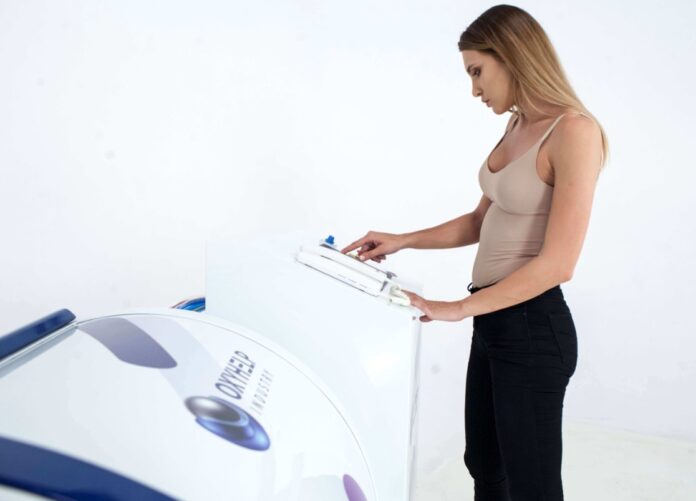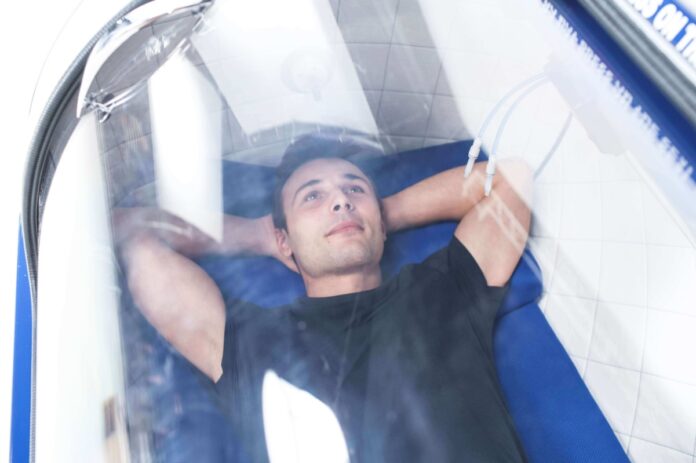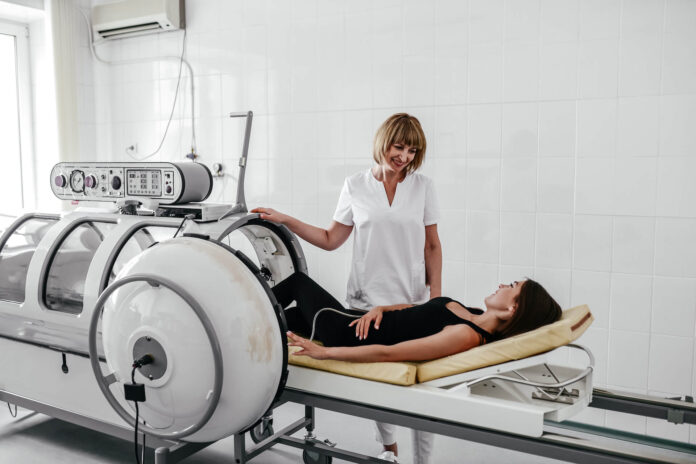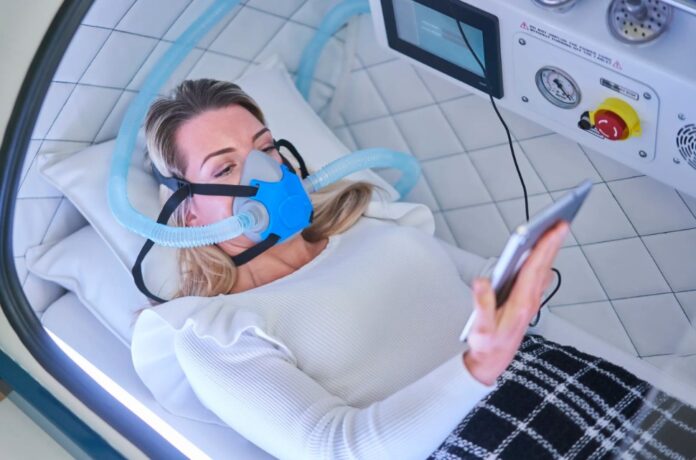
Hyperbaric Oxygen Therapy (HBOT) has emerged as a significant medical treatment, gaining attention for its diverse health benefits.
In this therapy, patients are placed in hyperbaric oxygen chambers where they breathe in pure oxygen at higher-than-normal air pressures.
This process is known to accelerate healing and improve various medical conditions. A common question about this therapy is its duration—how long does a typical session last, and what is the overall course of treatment?
How do They Work?
Hyperbaric Oxygen Therapy involves the use of hyper chambers to deliver 100% oxygen at high pressure, significantly higher than the ambient air pressure at sea level. This therapy is designed to increase oxygen delivery to the body’s tissues, which can accelerate healing processes and aid in the treatment of various conditions such as decompression sickness, serious infections, wound healing, and more recently, in some cases of neurorehabilitation.
At the core of HBOT are the hyperbaric oxygen chambers. These chambers can be large enough to accommodate several patients at once or smaller, personal chambers designed for individual use.
The principle behind these chambers is to create an environment where the body can absorb more oxygen than would be possible under normal atmospheric conditions. This increased oxygen absorption can lead to enhanced tissue repair, reduced inflammation, and other beneficial health effects.
Factors Influencing HBOT Duration

The duration and overall course of Hyperbaric Oxygen Therapy (HBOT) sessions are highly variable, and influenced by a multitude of factors. Key among these is the specific medical condition being treated.
Each condition responds differently to HBOT; for example, chronic wounds such as diabetic ulcers might require a longer treatment duration for effective healing, whereas acute conditions like carbon monoxide poisoning could be resolved with shorter but more intensive sessions.
The severity of the condition plays a crucial role as well. More severe cases may necessitate extended or more frequent HBOT sessions to achieve the desired therapeutic effect. On the other hand, less severe or early-stage conditions might respond well to shorter treatment durations.
A patient’s overall health status is another critical factor. Individuals with underlying health issues or those who are more sensitive to changes in pressure and oxygen levels might require a more carefully modulated treatment schedule. This could mean shorter sessions or a longer overall treatment period to allow the body to adjust and respond appropriately.
The goals of the therapy also dictate the duration of HBOT. For instance, if the goal is to rapidly reduce symptoms of a condition, more frequent sessions might be scheduled. Conversely, for long-term health improvement or maintenance, the therapy might be spread out over a longer period with less frequent sessions.
The type of hyperbaric chambers used significantly impacts the treatment duration as well. Professional hyperbaric oxygen chambers, typically found in medical facilities, are designed for a broad range of conditions, including severe and emergency cases. These chambers can accommodate longer and more frequent sessions.
Meanwhile, hyperbaric oxygen machines for home use are generally geared towards less severe conditions or for ongoing maintenance therapy. The sessions in home-based chambers may be shorter in duration, but they offer the convenience of frequent, easily accessible treatments.
Typical Duration of a Single HBOT Session

A single HBOT session usually lasts about 90 to 120 minutes. During this time, patients are comfortably seated or lying down inside the hyperbaric chambers. The session includes a period for the chamber to pressurize, the treatment time at the prescribed pressure, and time to depressurize the chamber at the end of the session.
The actual time spent at the therapeutic pressure level can vary, but it typically ranges from 60 to 90 minutes. This duration is carefully calculated to ensure that the body absorbs an optimal amount of oxygen without causing discomfort or oxygen toxicity. The process is closely monitored by healthcare professionals to ensure safety and effectiveness.
The Overall Course
The overall course of HBOT treatment can range from a few sessions to several weeks or months, depending on the condition being treated. For acute conditions, a shorter treatment course may be sufficient, often involving daily sessions for a set number of days or weeks. Chronic conditions, on the other hand, may require a longer treatment course, potentially involving regular sessions over several months.
For example, in the treatment of diabetic foot ulcers, a common course might include daily sessions five days a week for several weeks. The specific duration and frequency of sessions are determined based on the patient’s response to the treatment and the healing progress observed.
Monitoring and Adjusting Treatment Duration
The duration of HBOT treatment is not a one-size-fits-all prescription. It requires careful monitoring and occasional adjustments by healthcare professionals. Throughout treatment, patients are regularly assessed for their response to the therapy.
Healthcare providers may adjust the number of sessions or the duration of each session based on the patient’s progress. This personalized approach ensures that each individual receives the right amount of therapy to meet their specific health needs.
Long-Term Use of HBOT

For chronic conditions or those seeking ongoing health benefits, long-term use of HBOT may be considered. In such cases, maintenance sessions using hyperbaric oxygen machines at home can be an effective way to continue receiving the benefits of the therapy.
These maintenance sessions are typically less frequent than the initial intensive treatment phase and are tailored to the individual’s long-term health goals. It is important to note that long-term use of HBOT should always be under the guidance of a healthcare professional to ensure safety and effectiveness.
The Bottom Line
The duration of Hyperbaric Oxygen Therapy sessions and the overall course of treatment can vary widely. It is influenced by the type of condition being treated, the severity of the condition, the type you used, and individual patient factors.
Whether receiving treatment in professional hyperbaric chambers or using hyperbaric oxygen machines at home, patients need to follow the guidance of their healthcare providers to ensure safe and effective treatment.





